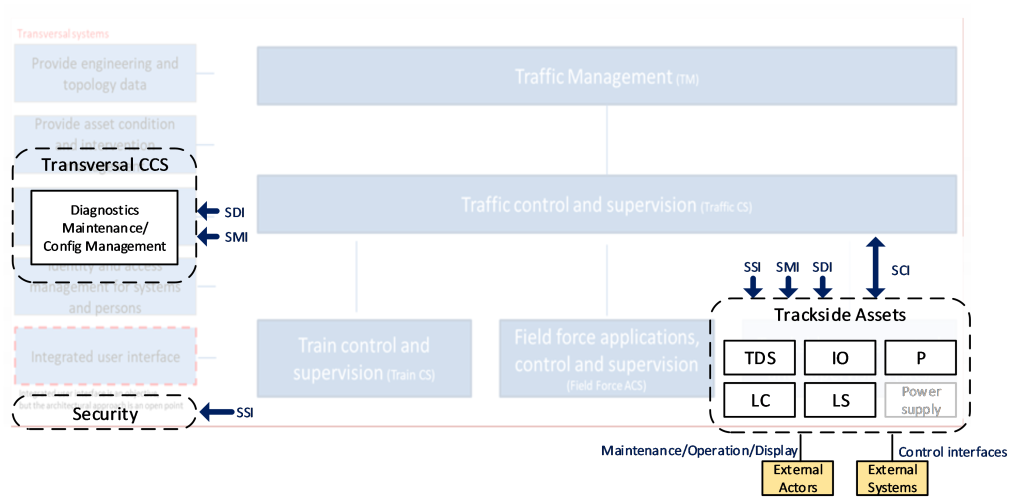2025 saw Europe’s Rail (EU-Rail) make significant progress across multiple initiatives, fostering partnerships and...

In June 2023 the Europe’s Rail Joint Undertaking, in close collaboration with EULYNX, published the very first set of System Pillar documents. The EULYNX Baseline Set 4 Release 2 documentation aimed to standardise interfaces and elements of the rail signalling systems in Europe. Today the System Pillar (SP) Steering group has approved the EULYNX Baseline set 4 Release 3.
Ongoing investments with multiple running and planned projects, together with corresponding industry developments, all require a stable and future-proof basis for procurements and developments. This publication by EU-Rail System Pillar and EULYNX provides the stable basis for current investments related to the EULYNX architecture and ensures both migration and compliance to the future System Pillar target architecture.
The Trackside Assets (TACS) domain continued the developments and improvements of the Trackside Assets specifications on the basis of the results published in Baseline set 4 Release 2 in June 2023. In addition, for the topics related to diagnostics, maintenance, and configuration management, the domain closely worked together with the Transversal CCS (TCCS) domain in dedicated task forces.
The scope of the Baseline set 4 Release 3 is identical to the previous release, with an addition of a new specification related to communications as per updated domain remit: Specification of Point of Service – Signalling specifies the requirements between the communication participants and the communication network.
Overview of the results
The results are technical specifications on System Level 5 (Physical components) in the form of subsystem and interface specifications.
The TACS system is composed of following subsystems:
Each subsystem is specified with a set of generic and subsystem specific requirements specifications.
The subsystem Light Signal is defined as part of the Trackside Assets CS to support migration scenarios. National signalling is out of the scope of the System Pillar target architecture.
The following interfaces are specified for communication with the Traffic CS:
The following interfaces are specified for communication with the Transversal CCS for maintenance and diagnostics:
The security requirements for shared security services and related SSI interface are in development by the Security domain. As the work of the Security domain fully integrates EULYNX BL4R2 specifications, the EULYNX BL4R3 publication will no longer contain separate EULYNX security specifications. References have been made to the upcoming release of the SP Security domain.
For validating the defined modelled requirements, simulators for the subsystem and interface behaviour have been developed and are also delivered by the domain as supporting artefacts.

Overview of the Trackside Assets Scope
The transmission of information objects between the communication participants shall be provided by the Communication System. As mandated by the extended domain remit, the TACS domain has integrated the matching EULYNX specification for Point of Service – Signalling. This specification describes the requirements for the Point of Service – Signalling for its network and security components and their interfaces with communication participants. The definition of the PoS-Signalling provides the lower layers (network layer, data link layer and physical layer) of the protocol stacks of the standardised interfaces.
Summary of changes
The TACS domain focused on outstanding open issues from BL4R2, harmonisation proposals and change requests introduced by the participants, and completion of all specifications.
Alignments and improvements with functional impact are summarised by the following change requests:
Newly introduced functions are summarised by the following change requests:
The remaining development on SDI diagnostic data points was done for Subsystem Train Detection System (for track circuits and train detection points) and Subsystem Level Crossing, completing the full set of SDI specifications. In addition, revisions of SDI diagnostic points were done to improve the consistency across the diagnostic model.
A lot of effort was placed on improving the understanding and readability of specifications and identifying potential gaps. Overall, approximately 250 editorial tickets were handled and resolved in the preparation of BL4R3.
Backwards compatibility within this release has been managed with the »Backwards compatibility guideline« and the version handling is ensured.
This release finalises the developments and brings stability to the Baseline set 4.
Click here to find out more: Trackside Assets Specifications